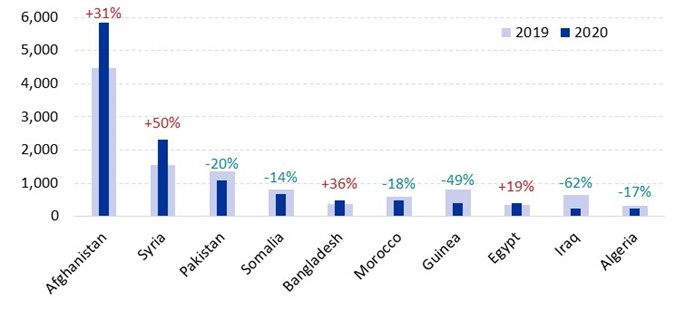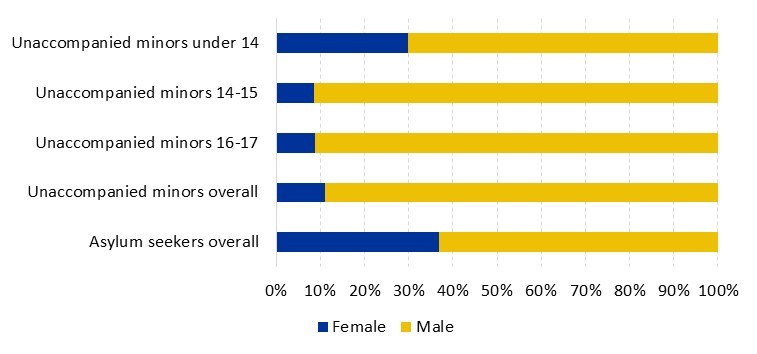5.1.1 Data on unaccompanied minors According to the Eurostat Technical Guide, applications for international protection by unaccompanied minors are counted as such when the age of the applicant has been accepted by the national authority. The age reported is determined through an age assessment procedure, when required.
According to the Eurostat Technical Guide, applications for international protection by unaccompanied minors are counted as such when the age of the applicant has been accepted by the national authority. The age reported is determined through an age assessment procedure, when required.
In 2020, about 14,200 applications for international protection were lodged by unaccompanied minors in EU+ countries, representing 3% of the total 485,000 applications. Compared to 2019, the absolute number of unaccompanied minors remained relatively stable (-3%). However, given the strong overall decrease in asylum applications, this resulted in an increase in the share of unaccompanied minors from 2019 by one percentage point.
More than one-half of all applications by unaccompanied minors were lodged in four countries: Greece (20% of the total), Germany (16%), Austria (10%) and Belgium (9%). In Greece and Germany, applications by unaccompanied minors decreased by 16% and 18% respectively, whereas they rose by 59%in Austria and remained stable in Belgium.
Despite the stability in the absolute number of unaccompanied minors arriving to Europe overall, there were great variations at the country level. Most notable were the increases in some countries on the Western Balkan route. With 980 applications by unaccompanied minors, Romania received more than five times as many children than in 2019, and in Croatia (with 115 applications), their number increased more than three times. While the overall number of applications in these countries also increased from the previous year, the rise in applications by unaccompanied minors was much higher. In Bulgaria (800), applications from unaccompanied minors rose by more than half.
Other notable relative increases occurred in Finland (+53%) and Switzerland (+22%). Conversely, the most noteworthy decreases in relative terms took place in Cyprus (-66%), Sweden (-43%), Denmark (-26%) and Italy (-21%).lxxiii
In relative terms, some countries located along the Western Balkan route also had the highest shares of unaccompanied minors among the total applicants. In Bulgaria, more than one in five applicants was an unaccompanied minor, about one in six in Romania and Slovenia, and one in ten in Austria. In fact, the share of unaccompanied minors in Romania more than doubled from 2019. Other countries with relatively high shares of children applying for asylum included Denmark and Portugal (10% each).
A large share of unaccompanied minors originated from Afghanistan, representing 41% of applications by minors in EU+ countries in 2020 (up by 11 percentage points from 2019). This was followed by Syria, with 16% (up by 6 percentage points). Children from both nationalities accounted for an increased number of applications in both relative and absolute terms. In fact, the number of Syrian unaccompanied minors rose by more than one-half from 2019, while Afghans minors increased by about one-third (see Figure 4.26).
Other nationalities with high numbers of unaccompanied minors were Pakistani, Somali and Bangladeshi. While there were fewer Pakistani and Somali minor applicants compared to 2019, the number of Bangladeshis rose by almost two-fifths. A noteworthy increase was also reported for unaccompanied minors from Egypt.
In contrast, the number of unaccompanied minors from some sub-Saharan African countries seems to have significantly dropped, including those from Cameroon, the Democratic Republic of Congo, Eritrea, Guinea, Nigeria and Sudan. Other significant decreases were reported for Albanians, Iranians, Iraqis and Palestinians.lxxiv
Unaccompanied minors from Afghanistan tended to mostly apply in Greece, Belgium and Romania (in descending order), making up over 70% and 80% of all minor applicants in the latter two countries, respectively. Almost one-half of all applications by Afghan minors were concentrated in these three countries.
 |
While the number of asylum applications by unaccompanied minors decreased overall, there were significantly more child applicants from Afghanistan and Syria |
Figure 4.26: Number of applications by unaccompanied minors by Top 10 countries of origin, 2020 compared to 2019
Source: Eurostat [migr_asyappctza] as of 28 April 2021.
Greece also received a large concentration of Pakistani and Bangladeshi unaccompanied minors relative to their applications in EU+ countries overall, receiving about two-thirds of their applications in 2020. In contrast, applications by Syrian and Somali minors were not concentrated in one particular country. Just over one-fifth of all Syrian unaccompanied minors applied in Germany, with another one-fifth applying in the Netherlands, and about one-sixth each in Austria and Greece. One-fifth of unaccompanied minors from Somalia applied in Germany. About one-half of Egyptian and Guinean unaccompanied minor applicants lodged their applications in Greece and Germany, respectively.
Afghanistan and Egypt were the countries of origin with the highest ratio of unaccompanied minors among their total applications, with 12% each, representing an increase of five and six percentage points, respectively. They were followed at a distance by Moroccans, Pakistanis and Somalis, with a ratio of 6% each.
As in previous years, the overwhelming majority of unaccompanied minors applying for international protection in EU+ countries were male (almost 9 out of 10). This was particularly the case for some Central and South Asian (Afghanistan, Bangladesh and Pakistan) and North African countries (Algeria, Egypt and Morocco).
In contrast, some sub-Saharan African countries accounted for relatively high shares of female minor applicants. One-half or more of all unaccompanied minor applicants from Nigeria and Côte d’Ivoire were girls. High shares of girls among all minor applicants were also noted from the Democratic Republic of the Congo and, to a lesser extent, Eritrea and Somalia. Another country of origin with an almost equal ratio of male and female unaccompanied minor applicants was Russia.lxxv
Most unaccompanied minor applicants were in the older age cohort, with about two-thirds aged between 16 and 17 years, and only about one-tenth below the age of 14. However, the share of girls was the highest in the youngest age group, accounting for almost one-third of applications in this group, compared to about one-tenth overall (see Figure 4.27). While most nationalities were more or less evenly distributed across all age groups, Russian minor applicants stood out, with children younger than 14 years making up more than four-fifths of all applications by Russian unaccompanied minors.
Turning from official Eurostat data, UNICEF Spain observed that the number of unaccompanied minors increased fivefold on the Canary Islands, based on regional government data. UNICEF Spain called for efficient contingency plans to rapidly assess the needs of migrant children and urged for a national action plan to be developed for the care and integration of unaccompanied minors.1272
 |
Overwhelming majority of unaccompanied minors who apply for asylum in EU+ countries are male, but there is a large share of girls under 14 years of age |
Figure 4.27: Gender ratio for unaccompanied minors by age group, 2020

Source: Eurostat [migr_asyappctza] as of 28 April 2021.

[lxxv] These were the highest female-to-male ratios in the Top 20 countries of origin for unaccompanied minors.
_____________
[1272] UNICEF Spain. (2021, February 5). Preocupados por la situación de los niños migrantes en las Islas Canarias [Concerned about the situation of migrant children in the Canary Islands]. https://www.unicef.es/noticia/preocupados-por-la-situacion-de-los-ninos-migrantes-en-las-islas-canarias




